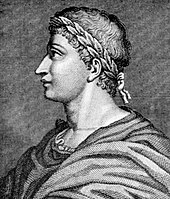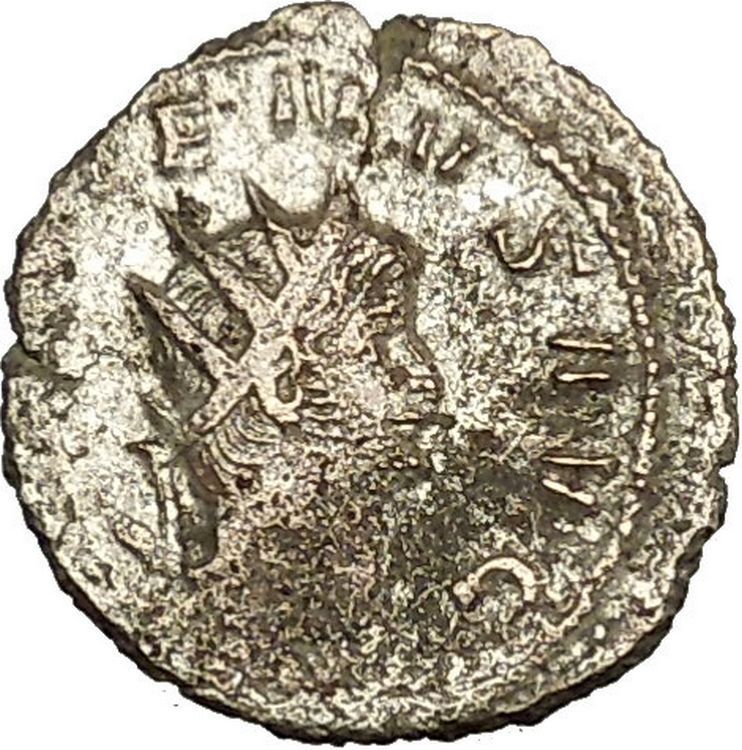|
Gratian
–
Roman Emperor
: 367-383 A.D.
Bronze AE4 13mm (1.21 grams) Constantinople mint: 378-383 A.D.
Reference: RIC 24
–
DNGRATIANVSPFAVG – Diademed, draped and cuirassed bust right.
VOT/XV/MVLT/XX Exe: CON – Wreath, legend within.
You are bidding on the exact item pictured,
provided with a Certificate of Authenticity and Lifetime Guarantee of
Authenticity.
Flavius Gratianus (18 April/23 May 359 – 25 August
383), known usually by the
anglicised
name Gratian, was a
Western Roman Emperor
from 375 to 383.
He favoured the Christian religion against
Roman polytheism
, refusing the traditional polytheistic attributes of the
emperors and removing the
Altar of Victory
from the
Roman
Senate
.
//
Life
Gratian was the son of Emperor
Valentinian I
by Marina Severa
, and was born at
Sirmium
(now
Sremska Mitrovica
,
Serbia
) in
Pannonia
.
He was named after his grandfather
Gratian the Elder
. Gratian was first married to
Flavia Maxima Constantia
, daughter of
Constantius II
. His second wife was
Laeta
. Both
marriages remained childless. His stepmother was Empress
Justina
and his paternal half siblings were Emperor
Valentinian II
,
Galla
and Justa.
On 4 August 367 he received from his father the title of
Augustus
. On the death of Valentinian (17 November 375), the troops in
Pannonia proclaimed his infant son (by a second wife Justina) emperor under the
title of
Valentinian II
.
Gratian acquiesced in their choice; reserving for himself the
administration of the
Gallic
provinces
, he handed over
Italy
,
Illyricum
and
Africa
to Valentinian and his mother, who fixed their residence at
Mediolanum
.
The division, however, was merely nominal, and the real authority remained in
the hands of Gratian.
The
Eastern Roman Empire
was under the rule of his uncle
Valens
. In May,
378 Gratian completely defeated the
Lentienses
,
the southernmost branch of the
Alamanni
,
at the
Battle of Argentovaria
, near the site of the modern
Colmar
. Later
that year, Valens met his death in the
Battle of Adrianopole
on 9 August. Valens refused to wait for Gratian and
his army to arrive and assist in defeating the host of
Goths
,
Alans
and
Huns; as a result,
two-thirds of the eastern Roman army were killed as well.
In the same year, the government of the Eastern Empire
devolved upon Gratian, but feeling himself unable to resist unaided the
incursions of the barbarians, he promoted
Theodosius I
on 19 January 379 to govern that portion of the empire.
Gratianus and Theodosius then cleared the
Balkans
of
barbarians
in the
Gothic War (376-382)
.
For some years Gratian governed the empire with energy and
success but gradually sank into indolence, occupying himself chiefly with the
pleasures of the chase, and became a tool in the hands of the
Frankish
general Merobaudes
and bishop
St. Ambrose
of Milan
.
By taking into his personal service a body of Alans, and
appearing in public in the dress of a
Scythian
warrior, after the disaster of the Battle of Adrianopole, he
aroused the contempt and resentment of his
Roman troops
. A Roman general named
Magnus Maximus
took advantage of this feeling to raise the standard of
revolt in
Britain
and invaded Gaul
with a large army. Gratian, who was then in
Paris
, being
deserted by his troops, fled to
Lyon. There,
through the treachery of the governor, Gratian was delivered over to one of the
rebel generals, Andragathius, and assassinated on 25 August 383.
Empire
and religion
The reign of Gratian forms an important epoch in
ecclesiastical history, since during that period
Orthodox Christianity
for the first time became dominant throughout the
empire.
Under the influence of Ambrosius, Gratian prohibited
Pagan worship
at Rome
; refused to
wear the insignia of the
pontifex maximus
as unbefitting a
Christian
;
removed the
Altar of Victory
from the
Senate
House
at Rome, despite protests of the pagan members of the Senate, and
confiscated its revenues; forbade legacies of real property to the
Vestals
; and abolished other privileges belonging to them and to the
pontiffs. Nevertheless he was still
deified
after his death.
Gratian also published an edict that all their subjects
should profess the faith of the bishops of Rome and Alexandria (i.e., the Nicene
faith). The move was mainly thrust at the various beliefs that had arisen out of
Arianism
,
but smaller dissident sects, such as the
Macedonians
, were also prohibited.
A laurel wreath is a circular
wreath
made of interlocking branches and leaves
of the
bay laurel
(Laurus nobilis), an aromatic
broadleaf evergreen, or later from spineless butcher’s broom (Ruscus
hypoglossum) or cherry laurel (Prunus
laurocerasus). In
Greek mythology
,
Apollo
is represented wearing a laurel wreath
on his head. In
ancient Greece
wreaths were awarded to victors,
both in athletic competitions, including the ancient
Olympics
made of wild olive-tree know n n
as “kotinos“
(κότινος),[1]
(sc. at
Olympia
) and in poetic meets; in
Rome
they were symbols of martial victory,
crowning a successful commander during his
triumph
. Whereas ancient laurel wreaths are
most often depicted as a
horseshoe
shape, modern versions are usually
complete rings.
In common modern idiomatic
usage it refers to a victory. The
expression “resting on one’s laurels” refers to someone relying entirely on
long-past successes for continued fame or recognition, where to “look to one’s
laurels” means to be careful of losing rank to competition.
Academic use

Ovid
with laurel wreath, common in
poets.
In some countries the laurel wreath is used as symbol of the
master’s degree
. The wreath is given to young
masters in the
graduation ceremony
of the university. The word
“Laureate”
in ‘poet
laureate‘ refers to being signified by the laurel wreath. The
medieval Florentine poet and philosopher
Dante Alighieri
,[dubious
–
discuss
] a graduate of the
Sicilian School
, is often represented in
paintings and sculpture wearing a laurel wreath.
Laureato[3]
is the term used in Italy
to refer to any graduated student. In
some italian regions (Veneto,
Friuli-Venezia Giulia
and
Trentino
), right after the graduation ceremony
(in Italian: laurea), the student receives a laurel wreath and is allowed
to wear it for the rest of the day. This tradition was born in the
University of Padua
and since the end of the
19th century is common to all
northeastern Italian
universities.
At
Connecticut College
in the United States,
members of the junior class carry a laurel
chain
, which the seniors pass through during
commencement. It represents nature and the continuation of life from year to
year. Immediately following commencement, the junior girls write out with the
laurels their class year, symbolizing they have officially become seniors and
the cycle will repeat itself the following spring.
At
Mount Holyoke College
in
South Hadley, Massachusetts
, United States,
laurel has been a fixture of
commencement
traditions since 1900, when
graduating students carried or wore laurel wreaths. In 1902, the chain of
mountain laurel
was introduced; since then,
tradition has been for seniors to march across campus, carrying and linked by
the chain. The mountain laurel represents the
bay laurel
used by the
Romans
in wreaths and crowns of honor.[4]
At Reed College
in
Portland, Oregon
, United States, members of the
senior class receive laurel wreaths upon submitting their senior
thesis
in May. The tradition stems from the use
of laurel wreaths in athletic competitions; the seniors have “crossed the finish
line,” so to speak.
At
St. Mark’s School
in
Southborough, Massachusetts
, students who
successfully complete three years of one classical language and two of the other
earn the distinction of the Classics Diploma and the honor of wearing a laurel
wreath on Prize Day.
In Sweden
, those receiving a Doctorate or an
Honorary Doctorate
at the Faculty of Philosophy
(meaning Philosophy, Languages, Arts, History and Social Sciences), receive a
laurel wreath during the ceremony of conferral of the degree.
Architectural and decorative arts motif

“Victory, A Knight Being Crowned With A Laurel Wreath” by
Frank Dicksee
.
The laurel wreath is a common motif in
architecture
,
furniture
, and
textiles
. The laurel wreath is seen carved in
the stone and decorative plaster works of
Robert Adam
, and in
Federal
,
Regency
,
Directoire
, and
Beaux-Arts
periods of architecture. In
decorative arts, especially during the
Empire period
, the laurel wreath is seen woven
in textiles, inlaid in marquetry, and applied to furniture in the form of gilded
brass mounts.
Alfa Romeoo
added a laurel wreath to their
logo after they won the inaugural Automobile World Championship in
1925 with the
P2
racing car.
|





 n
n





